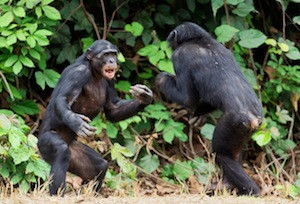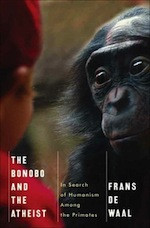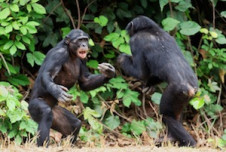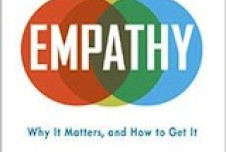When newspaper headlines recently screamed that both humans and chimpanzees are “natural born killers,” this was obviously hype. Not only were some articles accompanied by a picture of two playing chimps, with their mouths wide open the way apes laugh (which was mistaken for aggression), there was a much deeper flaw. The media frenzy was instigated by a Nature paper that reported 152 confirmed, inferred, or suspected killings among wild chimpanzees, mostly by males—and only one suspected killing among wild bonobos.
Why was the second data point ignored? Is the peacefulness of a close relative not worth reporting on?
The media were eager to follow Winston Churchill’s line, who long before he earned his reputation as a warrior wrote: “The story of the human race is War. Except for brief and precarious interludes, there has never been peace in the world; and before history began, murderous strife was universal and unending.”
No one denies our warrior potential, but Churchill may have gotten the interludes wrong. Contemporary hunter-gatherer groups co-exist peacefully most of the time. This probably applied even more to our ancestors on a planet with extremely low population densities. We may need to turn Churchill’s dictum around and speculate that our lineage experienced long stretches of harmony interrupted by brief interludes of territorial confrontation.
We simply don’t know. This is what is so puzzling about the assumption that humans in a “state of nature” (as if such a thing ever existed) would be waging continuous war, and the accompanying assumption that human prehistory is best understood from the male perspective. Violent scenarios inevitably turn around males, with females being the prizes rather than the engines of evolution.
I call it Single Quadrant Anthropology (SQA), because even though every human evolutionary scenario has two genders to work with, and the behavior of two equally close extant ape relatives to consider, only one out of the four possible comparisons is favored. It is all about males and chimpanzees. The male focus has given us the “Man the Hunter” hypothesis, books about the adaptive value of rape, or how the human brain is first of all a male brain that advertises its fitness to females. The chimpanzee focus is recognizable in books with depressing titles such as Demonic Males, and uplifting ones such as The Better Angels of Our Nature, which promote this ape species as the only realistic model to understand where we come from.
Not only are bonobos ignored, they are actively pushed out of the picture. They are too peaceful, too female-dominated, too gentle for the taste of many anthropologists and evolutionary psychologists. They simply don’t fit.
 They look like they're fighting—but in fact these two bonobos are playing.
They look like they're fighting—but in fact these two bonobos are playing.
In 2009, Kent State University came out with a press release under the shocking headline “Man Did Not Evolve from Apes.” Kent State had been involved in the discovery of Ardipithecus ramidus, also known as “Ardi,” a 4.4-million-year-old fossil from Ethiopia. Inevitably, creationists and intelligent-designers jumped on the misleading press release as a gift from God. The confusion arose because a scientist on the Ardi team, despite being blessed with the bonobo-like name of Owen Lovejoy, concluded that Ardi’s physique was too different to have come from a chimp-like forebear. Ardi’s less protruding mouth and relatively small, blunt teeth clearly set her apart from the chimpanzee in which males are equipped with long, sharp canines.
But what if we descend not from a blustering chimp-like ancestor but from an empathic bonobo-like ape? The bonobo’s body proportions—its long legs and narrow shoulders, even its grasping feet—seem to perfectly fit the descriptions of Ardi, as do its relatively small canines.
Why was the bonobo overlooked? What if the chimpanzee, instead of being an ancestral prototype, is in fact a violent outlier in an otherwise relatively peaceful lineage? Ardi is telling us something, and there may exist little agreement about what she is saying, but why do I always hear the drums of war while listening to evolutionary scenarios. This has been going on unabated since Konrad Lorenz and Robert Ardrey.
Bonobo are most of the time marginalized. The recent genome data confirm that bonobos and chimpanzees are equidistant to us, and genetically exactly equally similar to (or different from) us. Yet, most anthropology texts about our ape ancestry mention the species only to say how lovely and charming they are, immediately followed by how we can safely ignore them. They are not to be taken seriously. Even their endangered status has been held against them. Anthropologist Melvin Konner once advocated attention to chimpanzees rather than bonobos by saying “And in any case, chimps have done far better than bonobos, which are very close to extinction.”
I have no trouble with the conclusion of the authors of the Nature paper, led by Michael Wilson of the University of Minnesota, according to which chimpanzee violence is a natural behavioral tendency that is not a product of human interference. The interference hypothesis perhaps made sense in the days when Jane Goodall maintained a banana camp for her apes, but those days are long gone. Most of the evidence for violence in the wild now comes from chimpanzee communities that never received any extra food from humans. I have witnessed enough chimpanzee violence first-hand to understand what they are capable of, and have little doubt that field workers are right that chimps use violence to achieve dominance or expand their territory.
No, my beef is rather with the exclusive focus on one ape species and one gender, and the highly speculative nature of the claim that we have continuously been at war since the split between ape and human lineages. Although archeological signs of individual murder go back hundreds of thousands of years, similar evidence for warfare (such as graveyards with weapons embedded in a large number of skeletons) is entirely lacking from before the Agricultural Revolution of about 12,000 years ago. We have no data to make any claims about warfare before this time.
 De Waal's most recent book is The Bonobo and the Atheist.
De Waal's most recent book is The Bonobo and the Atheist.
Consider a different scenario. Let’s say we descend from peaceful bonobo-like apes, which mingled at their borders without any violence, the way wild bonobos are known to do today. Instead of fighting, they have sex and groom each other. Like Ardipithecus, our ancestors were anatomically similar to bonobos and slowly developed more aggressive and territorial tendencies, which erupted into full-blown territorial combat only once we settled down and collected land and livestock. This was the main cause of warfare.
In the meantime, an offshoot of the ape branch, the chimpanzee, also became more violent, perhaps because of higher population densities or other reasons related to resources, but its behavior never resembled warfare in the human sense. It did not consist of one organized army meeting another, but was more like opportunistic raiding behavior, so that a comparison with warfare is problematic. The above scenario is equally compatible with the current knowledge about our history and prehistory as the bloody scenario reflected in the media headlines.
I for one would love to see science consider all options. This means inclusion of the female point of view—female reproduction, cooperation, competition, and care for offspring—as well as serious consideration of the make-love-not-war bonobo. The species may be embarrassing to some scholars the way 1960s hippies were to their parents, but it is time for us to explore all four quadrants of comparison rather than limiting ourselves for no good reason to just one of them.
This essay originally appeared in This View of Life, an online magazine that reports on evolution the way that Darwin imagined it—as a theory that applies to all aspects of humanity in addition to the rest of life.







Comments